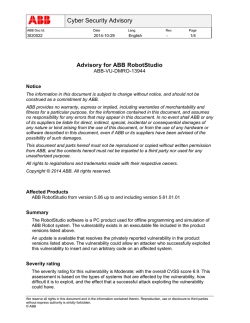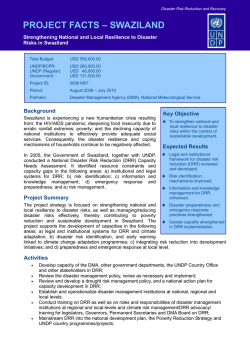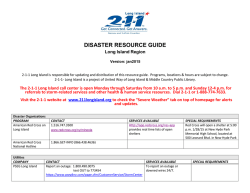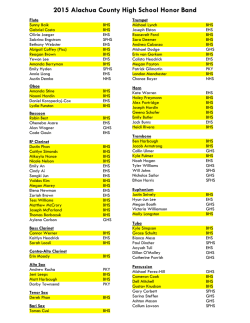
2015 Call for Applications - UNU-EHS
CALL FOR APPLICATIONS Announcement UNITED NATIONS UNIVERSITY Institute for Environment and Human Security Intensive Summer Course 2015 “Advancing Disaster Risk Reduction to Enhance Sustainable Development in a Changing World” 01-12 June 2015, UN Campus, Bonn Accepting applications until 7 March 2015 Location: UNU-EHS, UN Campus, Bonn, Germany Email: [email protected] We are inviting qualified PhD and Master’s students, as well as practitioners who have an interdisciplinary focus and are working on research related to vulnerability and resilience in the context of disaster risk reduction (DRR) and climate change adaptation (CCA) to apply for the UNU-EHS Course entitled “Advancing Disaster Risk Reduction to Enhance Sustainable Development in a Changing World” to be held 01st -12th June 2015 in Bonn, Germany. PhD students would ideally be in the early stages of their research while Master’s students in the advanced stage of their research. Applications of interested candidates must be submitted no later than 7 March 2015 via email to: [email protected] 1 Purpose The Institute for Environment and Human Security of the United Nations University (UNU-EHS) assesses the vulnerability and coping capacity of communities facing natural and human-induced hazards in a changing environment. It leads United Nations University’s (UNU) research and capacity building activities in the broad interdisciplinary field of risk and vulnerability. One of the institute’s major educational activities is the UNU-EHS Intensive Summer Course, which highlights the complexity and importance of vulnerability and resilience in DRR and CCA. The UNU-EHS Intensive Summer Course is offered every year and is designed for postgraduate candidates in the early stages of PhD research (or about to begin PhD studies) and advanced Master’s degree students but also for practitioners working in the fields of Disaster Risk Reduction (DRR) and Climate Change Adaptation (CCA). About the Intensive Summer Course The growing frequency and magnitude of extreme environmental events (such as floods, landslides and drought) have intensified research interest in these events, in particular regarding the level of risk they pose in different locations, the vulnerability of communities and their response capabilities. The concept of human security focuses on threats that endanger the lives and livelihoods of individuals and communities. Safeguarding human security requires a new approach and a better understanding of many interrelated variables (such as social, political, economic, technological and environmental factors) that determine the impact of extreme events when they occur. The overall goal of the Intensive Summer Course is to increase awareness regarding the complexity and importance of vulnerability and resilience in the fields of DRR and CCA. The Course is based on key research questions of UNU-EHS, and covers the following overarching themes: Environmental, physical, social, and economical dimensions of vulnerability; Processes and conditions that have an impact on vulnerability and determine vulnerability patterns (such as human mobility); Measures and activities which enable shifting from vulnerability to resilience policy recommendations (such as the use of insurance and risk transfer); International law and a rights based approach in the 2015 /Post-2015 discussions on DRR, development, and climate change; Using methods, models, geospatial technologies and hands-on practical exercises for understanding early warning systems, emergency response preparedness, DRR and CCA; Disaster coordination and management within national and international organizations (such as the UN). The time allotted for the Course is two weeks. 2 Units and Learning Objectives Epistemology / History of Risk, Vulnerability and the Anthropocene observing the “Anthropocene” – is it an effective paradigm to describe the cumulative impact of civilization and the way humans have modified earth? understand the evolution of the field learn the major theories and concepts in the field understand different types of risk, hazards, vulnerability, etc. Methodology (epistemic chain) and Indicator development learn processes and tools of identifying, quantifying, and prioritizing (or ranking) the vulnerabilities and risks learn how to develop indicators Political ecology of risk understanding the interplay between societies at risk, those who are vulnerable and how policies are shaped Why ecosystems matter for DRR and CCA awareness of the role and opportunities of ecosystems and ecosystem services in disaster risk reduction understanding the principles and approaches of ecosystem based disaster risk reduction and climate change adaptation (EcoDRR/CCA) understanding the concept of the ecosystem services (ES) approach and being able to identify ES in specific case studies awareness of the advantages, co-benefits and limitations of EcoDRR knowledge of different approaches on how to assess the potential of ecosystem-based disaster risk reduction awareness of synergies with development planning processes and biodiversity conservation Urban vulnerability understanding the impact that climate change and other hazards have on urbanized populations and infrastructure Looking at human-made hazards: e-Waste creating awareness about e-waste management and sustainable electronics cycles Climate Change and International Law learn how principles of international law are relevant to climate change, particularly concepts such as hybrid law gain an understanding of how international law and a rights based approach are featuring in the landmark 2015 / post2015 discussions on disaster risk reduction, development, and climate change Climate change, environmental change and migration learn about most recent research on climate change and human mobility gain awareness of the key debates about climate change and human mobility 3 How insurance and risk transfer can help vulnerable communities and countries increase their resilience against weather shocks learn how insurance and risk transfer can reduce the stress that communities suffer from weather impacts understand how the tool can improve the livelihoods of affected people by adding to their portfolio of risk management strategies and how it can prevent them from falling deeper into poverty by properly including them into the formal financial system Loss and Damage learn about the emerging concept of loss and damage, major issues and areas of discussion in policy and practice, and an overview of policy directions. gain understanding into a research approach and emerging methods toolkit to understand and measure loss and damage, featuring results from case studies. Regionalization and globalization of risk patterns learn about risk pathways and fundamental differences in risk profiles understand ‘meta analysis’ publication find out what is the global impact and learn about differences and similarities between countries and continents Tools of the trade: DRR, Remote Sensing and GIS learn about how space-based solutions (GIS / Remote Sensing) are being used to prevent and manage disasters in a globally changing environment learn who are the global mechanisms and players Putting Theory into Practice: rapid assessment applications simulation exercise gain hands-on experience regarding GIS/Remote Sensing doing a mapping simulation Conclusion wrapping up key concepts taught during the 2 weeks 4 Major Themes Covered Theme Topics Assignments Terminology Disaster risk management (DRM Terminology) • Hazard types • Historical spatial and temporal hazard distribution • Assessing hazards • Measuring hazards’ impact •Definition of a system •Infrastructure •Economical •Environmental •Social •Coupling two or more dimensions •Basic principles •Theoretical basis •Conceptual frameworks •Vulnerability and sustainable Development •Assessing vulnerability •Indicator and indices •Qualitative versus quantitative assessment •Input data collection methods •Vulnerability models •Progression of vulnerability •Root causes •Dynamic pressure •Unsafe conditions •Environmentally Induced Migration Comparative analysis of a disaster risk management terminology • Mapping historical hazards • Hazard frequency-magnitude- damage analysis Hazards Dimensions Vulnerability •Analysis of the basic elements of particular system •Practical exercise on describing applied systems •Discussion of the applicability different frameworks •Improved understanding of the Different conceptual and theoretical approaches •Perform data collection •Examples of qualitative analysis •Examples of quantitative analysis •Exercises using indicators and indices •Assessing vulnerability using selected models •Analysing root causes for different vulnerability patterns - context specific •Human mobility Qualitative tools and methods •Human mobility – stories info on cases 5 Coordinated Assessment and Information Management within the United Nations System • Emergency response and coordination • Response tools • Information management tools and processes Geospatial technologies and Early Warning Systems for Disaster Risk Management • Remote sensing (earth observation) • Navigation • Communication • GIS • Early Warning Systems Vulnerability to Resilience • On theory of resilience • Progression of resilience • Achieving safe conditions • Reducing hazard impact • Development of safety culture • IASC (Inter-Agency Standing Committee) Introduction to Coordinated Assessments in Humanitarian Crises (assessment approaches and methodologies for different phases of an emergency) • UN humanitarian system • UN response tools (OCHA: UNDAC, INSARAG) • MIRA (Multi-sectoral/cluster Initial Rapid Assessment) framework and process • Information management tools and processes • advice on integrating coordinated assessment outputs into decision making and strategic planning processes •Introduction of space based technologies for risk and disaster management •Discussion of various tools and methods • Analysis of existing international response and support mechanisms • Practical exercises Introduction to concept and implementation of early warning systems • Assessing progression of resilience • Achieving safe conditions for selected hazard • Steps towards a culture of resilience • Linking vulnerability assessment and adaptation strategies 6 By the end of the course student should be able to: - understand the multi-dimensional nature of vulnerability and the necessity for an interdisciplinary approach; critically evaluate and understand different concepts and frameworks of vulnerability analyse the role of vulnerability and resilience in disaster risk management and development planning; understand and implement models and methods for vulnerability assessment; implement measures and activities which enable shifting from vulnerability to resilience; have improved capacities to apply methods and tools; understand of use of technology in DRM. The final programme will be distributed before the start of the course to the participants. Course Organization and Materials The UNU-EHS Course consists of a series of lectures conducted by experts, students’ practical work, discussions, group work, and simulations. Upon completion of the course, participants will be given a certificate of completion by the UNU-EHS. Course materials will be provided by the UNU-EHS in class. A Course website will be set up and can be found at the following link: http://www.ehs.unu.edu/elearning. This website also provides reading materials for participants to read before the Course. Required Qualifications for Participants - Currently a postgraduate candidate (i.e. in the early stages of PhD research or about to begin PhD studies); and A Master’s degree in geography, economics, social science, engineering, anthropology, environmental and/or natural science or related disciplines; or Basic experience in vulnerability, risk and/or disaster management Fluency in English (B1/2) Basic computer user knowledge Application Process To apply for the UNU-EHS Course 2015, please submit the following materials: 1. A completed application form found on the UNU-EHS website (http://www.ehs.unu.edu/article/read/phd-block-course-from-vulnerability-toresilience-in-disaster) (REQUIRED) 2. Résumé/CV: A current résumé including a chronological listing of employment and other significant activities. (REQUIRED) 3. Motivation letter: Applicants must provide a written statement, one to two pages in length, describing their motivation, relevance of your research/ educational 7 background and practical experience to the Course, and why they feel participation in this course is relevant to their future work. (REQUIRED) 4. One letter of recommendation (REQUIRED) 5. For non-native English speakers, English language proficiency certificate. (RECOMMENDED) Completed applications must be submitted and received no later than 7 March 2015. Incomplete applications will not be considered. The UNU-EHS will select 20 applicants according to the qualifications and previous achievements. Notifications will be made in April 2015. Financial Information The UNU-EHS Intensive Summer Course is free of charge. Each participant is expected to finance (or seek funding) and to organize his/her travel, local transport, per diem, and accommodation. Please note that UNU-EHS will not provide for any of these costs. Experts* Mr. Thomas Abeling, PhD Researcher, emBRACE project (VARMAP), UNU-EHS Dr. Cosmin Corendea, Associate Academic Officer (EMSVA)/ Legal Expert, UNU-EHS Dr. Matthias Garschagen, Head of Section, Academic Officer (VARMAP), UNU-EHS Prof. Dr. Klaus Greve, Head of section for Geographic Information Systems, Department of Geography and Center for Remote Sensing of the Earth' Surface, University of Bonn Dr. Julia Kloos, Associate Academic Officer (EVES), UNU-EHS Dr. Ruediger Kuehr, Head of Operating Unit SCYCLE, UNU-IAS Mr. Andrea Milan, Research Associate MECLEP Project (EMSVA), UNU-EHS Ms. Joanna Pardoe, PhD Researcher, WASCAL project (VARMAP), UNU-EHS Dr. Fabrice Renaud, Head of Section (EVES), Academic Officer, UNU-EHS Prof. Dr. Jakob Rhyner, UNU Vice Rector for Europe, Director, UNU-EHS Dr. Zita Sebesvari, Associate Academic Officer (EVES), UNU-EHS Dr. Jörg Szarzynski, Head of Section (EGECHS), Educational Officer, UNU-EHS Dr. Koko Warner, Head of Section (EMSVA), Academic Officer, UNU-EHS Ms. Kristina Yuzva, Project Associate, MCII project (EMSVA), UNU-EHS Mr. Michael Zissener, Research Associate, MCII project (EMSVA), UNU-EHS *Subject to change For questions or further information about the UNU-EHS Intensive Summer Course please contact us via email: [email protected] 8
© Copyright 2026



